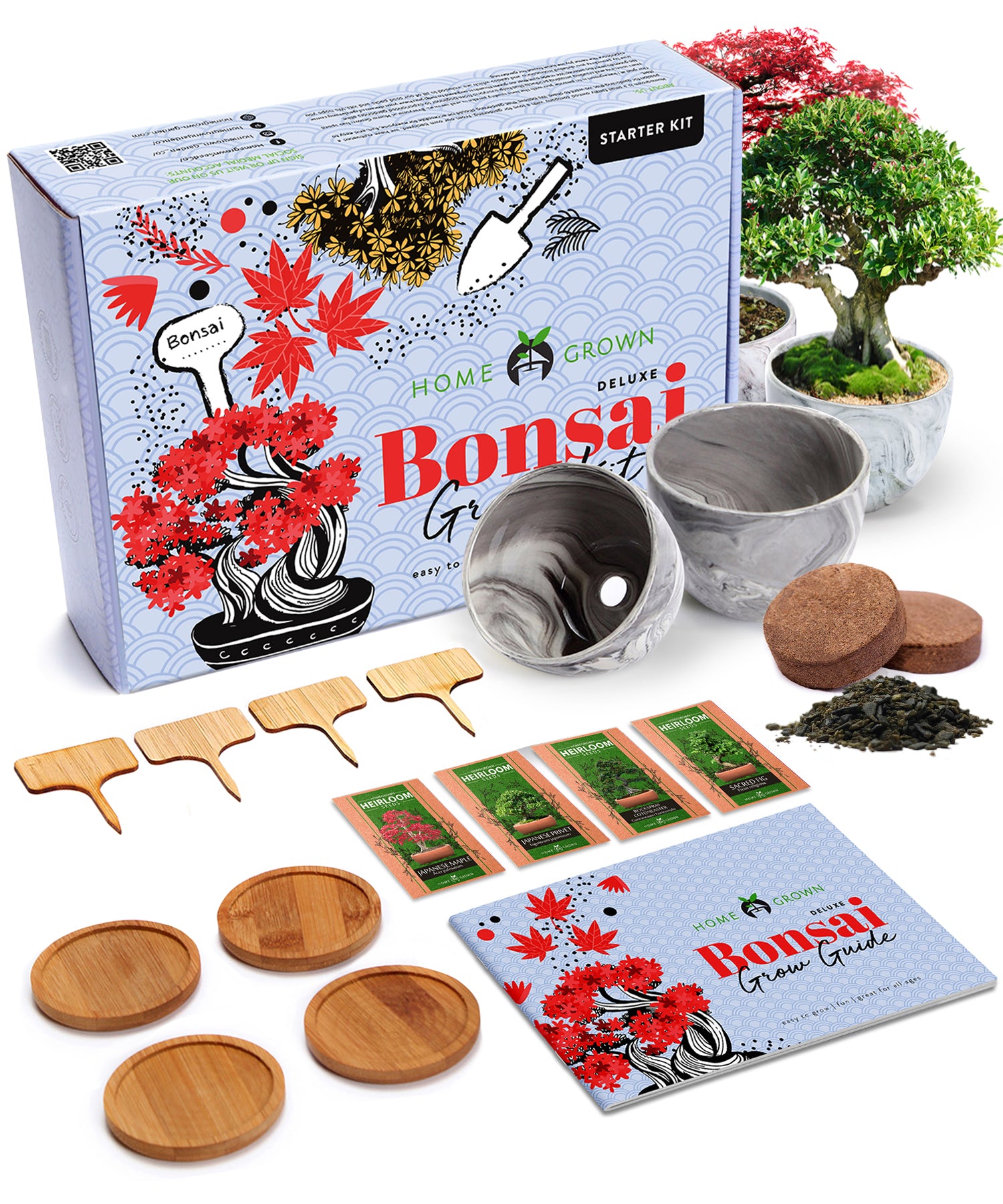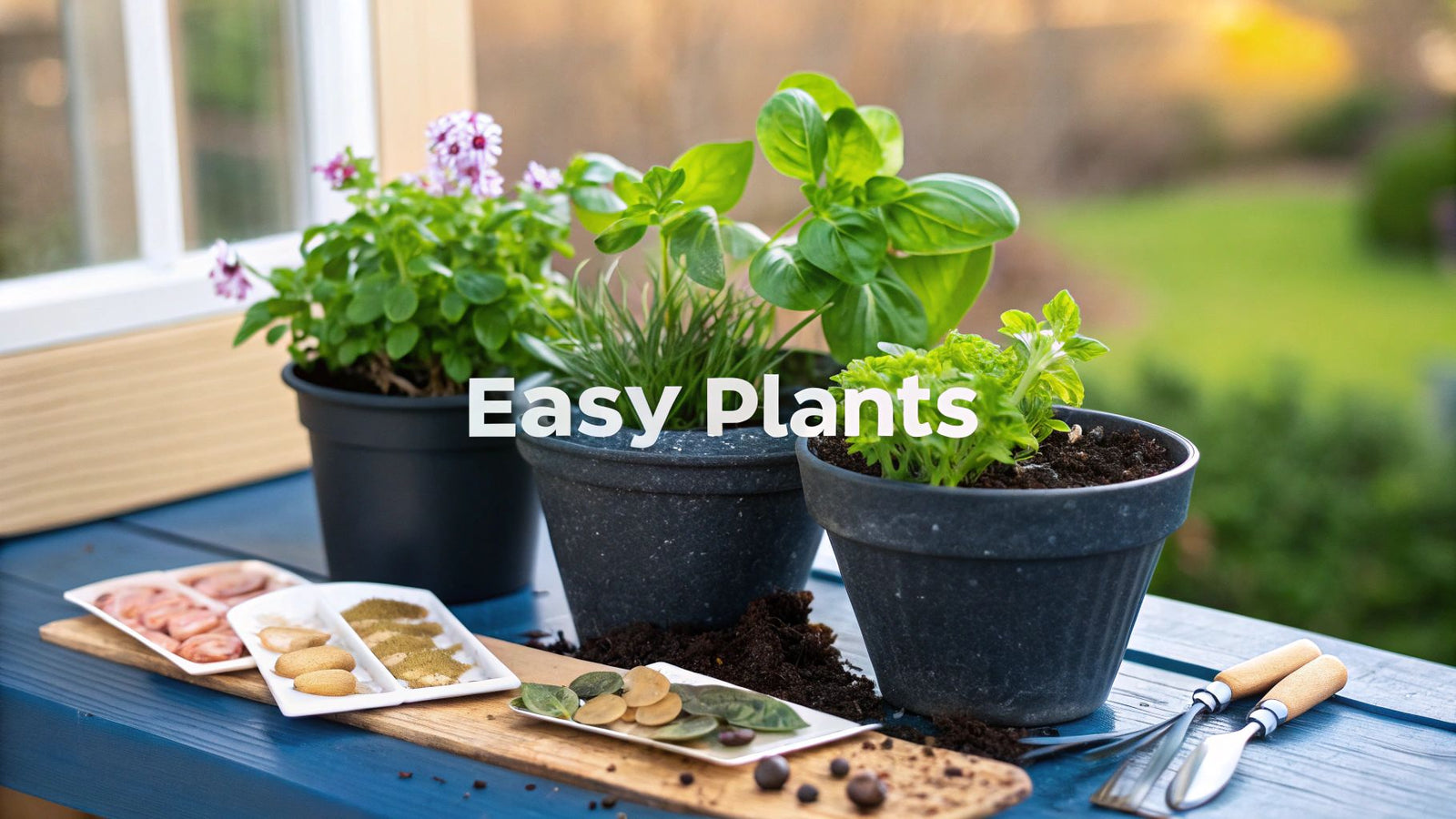
So, what makes a plant "easy" to grow? It really comes down to how much a plant can put up with while you're still learning the ropes. Think of plants like snake plants, spider plants, and leafy greens like arugula—they're incredibly forgiving of the classic beginner blunders, like forgetting to water or putting them in a less-than-perfect spot.
Starting with these tough-as-nails varieties is the best way to build your confidence and actually enjoy what you're doing.
What Makes a Plant Beginner-Friendly?
Before I just throw a list of plants at you, let's talk about why some are so much easier than others. I like to think of it as a plant's "forgiveness factor." The higher it is, the better your chances are of seeing that plant thrive, even if you mess up a few times.
These resilient plants all share a few key traits that make them perfect for anyone just getting their hands dirty in the garden.
The first big one is adaptability. The easiest plants aren't divas; they aren't picky about where they live. They can often handle a wide spectrum of light, from a sun-drenched windowsill to a dimmer corner of a room. This flexibility means you don't need a "perfect" spot to get started. Our guide on how to start a garden for beginners can help you scope out the right location in your home or yard.
Resilience to Common Mistakes
Another huge factor is how well a plant tolerates watering slip-ups—which is probably the number one reason houseplants meet an early demise. Forgiving plants have this amazing ability to bounce back from both too much and too little water. Succulents, for instance, are built for this; they store water in their plump leaves and can handle a little neglect. Then you have snake plants, which are famously tough and can go weeks without a drink.
The secret to success for new gardeners isn't about having a perfect 'green thumb.' It's about choosing plants that are naturally tough and can thrive despite a learning curve. These plants are designed by nature to be survivors.
Low Maintenance and Pest Resistance
Finally, the best plants for beginners don't demand a ton of your time. They're naturally good at fending off common pests and diseases, which means you're not constantly playing plant doctor.
A great example is the African violet. It's incredibly low-maintenance and even easy to propagate, making it a favorite for indoor gardeners. They do great in lower light and can flower all year with just a little bit of care, which is a huge win if you have a busy schedule. You can find more simple care tips and other easy plant suggestions over on Plant Cell Technology's blog.
The 5 Easiest Vegetables For Your First Harvest
There's nothing quite like walking into your own backyard to pick fresh vegetables for dinner. It’s one of the greatest rewards of gardening, and it's an experience anyone can have—no sprawling fields required. All you need is a few pots on the patio or a small patch of dirt to get started.
The trick is to begin with vegetables that are known for being forgiving and productive. Starting with cooperative plants helps you build confidence and see a real return on your effort, right from your very first harvest.
So, what makes a plant "easy"? It usually comes down to a few simple traits, like how much water it needs, whether it can handle a little neglect, and how well it fends off common pests. This infographic breaks it down perfectly.
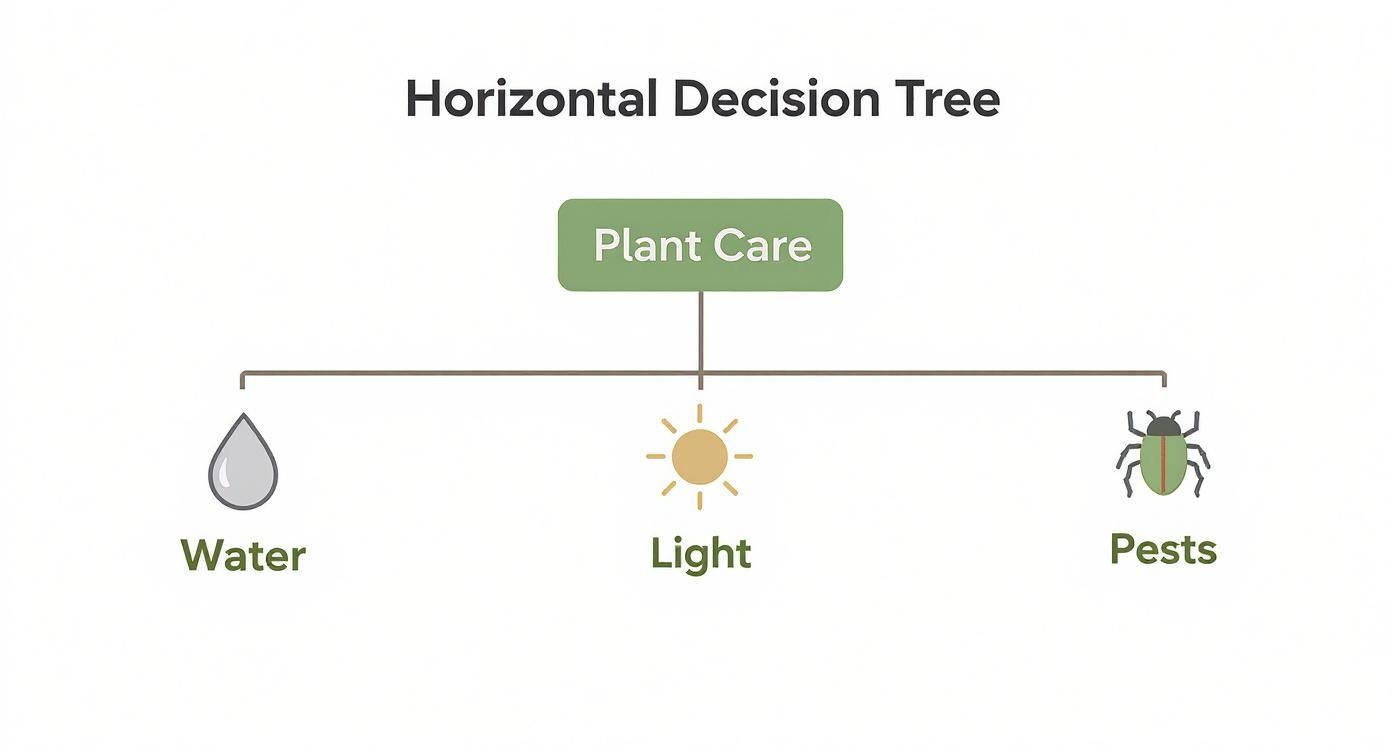
As you can see, plants that thrive with straightforward care are the best bet for any new gardener. Below are five reliable vegetables that fit this description perfectly, setting you up for a delicious and successful first season.
1. Leafy Greens
If you want fast results, leafy greens like lettuce, spinach, and arugula are your best friends. They grow incredibly quickly, which is a huge motivator when you're just starting out and eager to taste your own homegrown food.
Best of all, many are "cut-and-come-again" crops. This means you can snip off the outer leaves for a salad, and the plant will keep growing new ones from the center for weeks. That continuous harvest from a single planting is both efficient and deeply satisfying. Some lettuce varieties can be ready for baby leaf harvesting in just 25–30 days.
2. Zucchini and Summer Squash
Zucchini is famous for being ridiculously productive. Seriously, gardeners often joke about sneaking bags of it onto their neighbors' porches. Just one or two plants can easily supply you with squash all summer long, making it an incredibly rewarding choice for beginners.
These grow on big, bushy plants that need some room to spread out, but they’re otherwise pretty low-maintenance. Give them plenty of sun and consistent water, and they’ll take care of the rest. If you want a vegetable that guarantees a bountiful harvest, zucchini is a sure thing.
A classic piece of advice for new gardeners is to plant less zucchini than you think you need. A single plant can yield dozens of fruits, providing more than enough for a small family.
3. Radishes
Looking for near-instant gratification? Plant radishes. These peppery little root veggies are one of the fastest crops around, with some varieties ready to pull from the ground in only three to four weeks after planting seeds. Their speed is fantastic for keeping kids (and impatient adults!) engaged in the gardening process.
Radishes are also quite hardy. They prefer cooler weather, so you can plant them in early spring or fall. They don’t need much space and are perfect for tucking in between slower-growing plants. Just remember to thin the seedlings so the roots have enough room to get nice and plump.
4. Bush Beans
Forget about building complicated trellises. Bush beans are the easy-going cousin of pole beans, growing into compact, self-supporting plants that are a breeze to manage. They're also reliable producers, giving you handfuls of fresh green beans for weeks on end.
They also do something amazing for your garden soil. As "nitrogen fixers," they pull nitrogen from the air and store it in their roots. This enriches the soil, making it healthier for whatever you decide to plant there next season. They're a true team player.
5. Bell Peppers
Vibrant, crunchy, and surprisingly simple to grow, bell peppers are a fantastic addition to a beginner's garden. They absolutely love the heat and sun, so find them the sunniest spot you have. For the easiest start, pick up a young plant from a local nursery instead of starting from seed.
Once they're established, bell peppers just need consistent watering to thrive. Watching the fruits ripen and change from green to brilliant red, yellow, or orange is one of the most colorful and fun parts of summer gardening. They do great in the ground or in large containers, making them versatile for any space.
For an even deeper look at what to plant, check out our guide on the best vegetables to grow for beginners.
Beginner's Vegetable Growing Cheat Sheet
To make it even easier, here's a quick-reference table to help you decide which of these fantastic vegetables is the right fit for your garden.
| Vegetable | Sunlight Needs | Watering Frequency | Time to Harvest | Best For |
|---|---|---|---|---|
| Leafy Greens | 4-6 hours (part sun) | Consistently moist | 30-60 days | Quick harvests & small spaces |
| Zucchini | 6-8+ hours (full sun) | Deeply, 1-2 times/week | 45-60 days | Huge, reliable harvests |
| Radishes | 4-6 hours (part sun) | Consistently moist | 21-30 days | Instant gratification & kid's gardens |
| Bush Beans | 6-8+ hours (full sun) | When top inch of soil is dry | 50-65 days | Easy picking & improving soil |
| Bell Peppers | 6-8+ hours (full sun) | Consistently moist | 60-90 days | Sunny spots & container gardening |
This cheat sheet gives you a snapshot of what to expect. No matter which you choose, you're on your way to enjoying the unmatched flavor of food you've grown yourself.
3 Simple Steps to Growing Bell Peppers
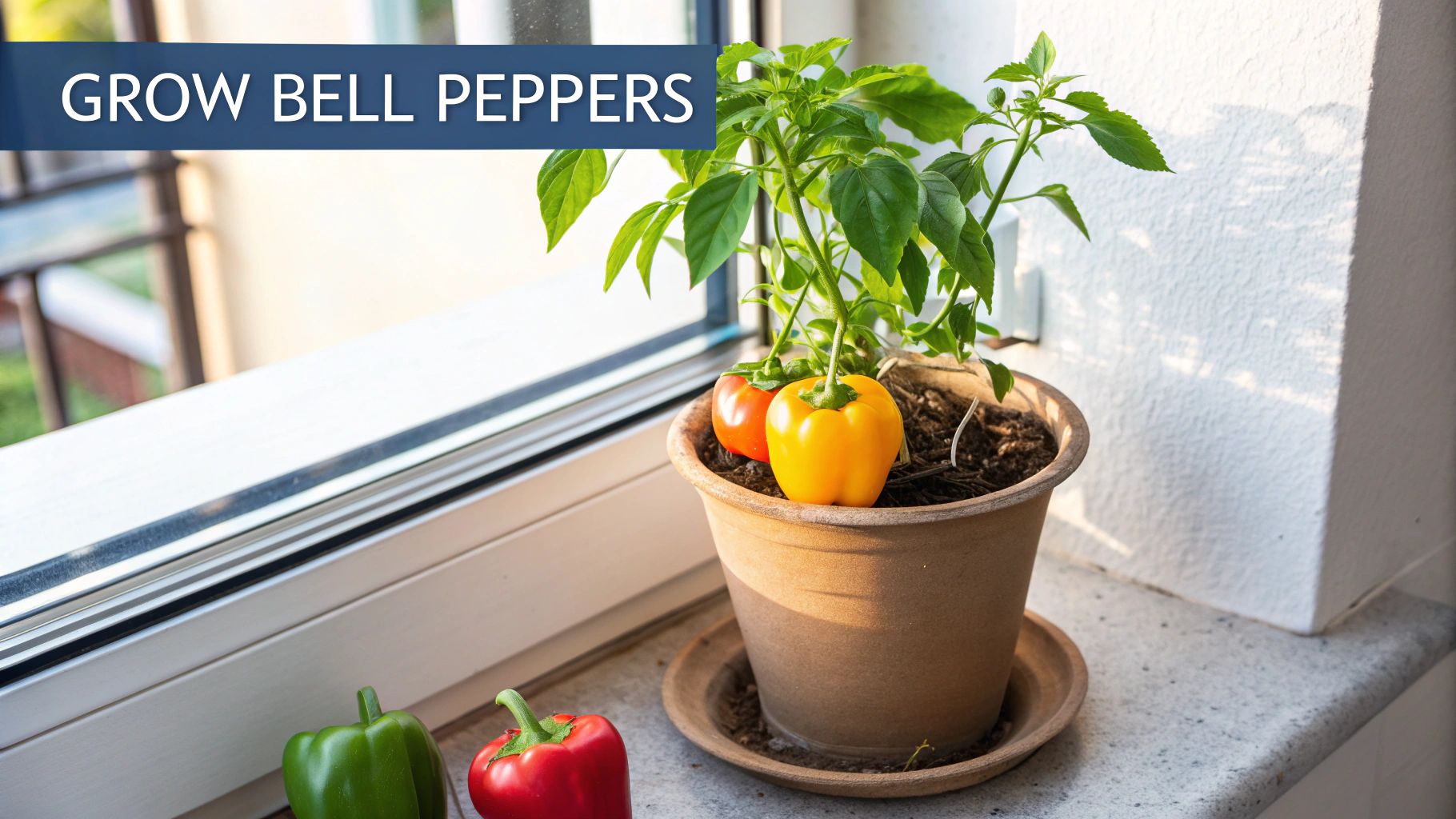
Bell peppers are one of those plants that just make you feel like a gardening pro. They bring a pop of brilliant color to the garden and a fantastic crunch to your meals. Plus, they love the summer sun and, with just a little care, will reward you with a steady crop of crisp, sweet fruit.
Think of bell peppers as total sun-worshippers. To really thrive, they need the sunniest spot you've got. Find a place that gets at least 6-8 hours of direct sunlight every day. All that sunshine is the fuel they need to grow big, glossy peppers. If they're stuck in the shade, you might get a lot of leaves but not much else.
What makes them such a great pick for new gardeners is how adaptable they are. They're often listed as one of the easiest vegetables to grow because they're self-pollinating and do just fine in containers. This is a huge win for anyone gardening on a balcony or small patio. You can see why they're a popular beginner choice over on Ecowatch.com.
1. Getting Started with Planting
Honestly, the simplest way to get a great harvest is to buy young starter plants from a local nursery. This lets you skip the tricky seed-starting process and puts you on the fast track with a healthy plant. If you're putting in a few, make sure to give them some elbow room—about 18 inches apart is perfect.
Peppers aren't too picky, but they love rich, well-draining soil. Before you plant, work a good amount of compost into the soil. This gives them the nutrient-packed start they need to flourish.
Gardener's Tip: When you're transplanting your pepper starts, plant them a bit deeper than they were in their nursery pot. This trick encourages the stem to grow more roots, which makes for a sturdier plant that can suck up more water and nutrients.
2. Watering for a Big Harvest
The key to getting plump, juicy peppers is consistent watering. You want the soil to stay evenly moist but never soggy. A good way to check is to just stick your finger in the soil; if the top inch feels dry, it's time to water.
3. Feeding for a Big Harvest
Bell peppers are also pretty hungry, especially once they begin to flower and set fruit. Keep them well-fed and happy with this straightforward schedule:
- At Planting Time: Mix a balanced, slow-release fertilizer right into the soil.
- After the First Peppers Appear: Start feeding them every 2-3 weeks. A liquid fertilizer formulated for tomatoes or vegetables is your best bet, as it will be high in potassium and phosphorus.
- Avoid Too Much Nitrogen: Be careful with high-nitrogen fertilizers. They'll give you a gorgeous, leafy green plant with almost no peppers to show for it.
The 4 Easiest Herbs for Instant Flavor
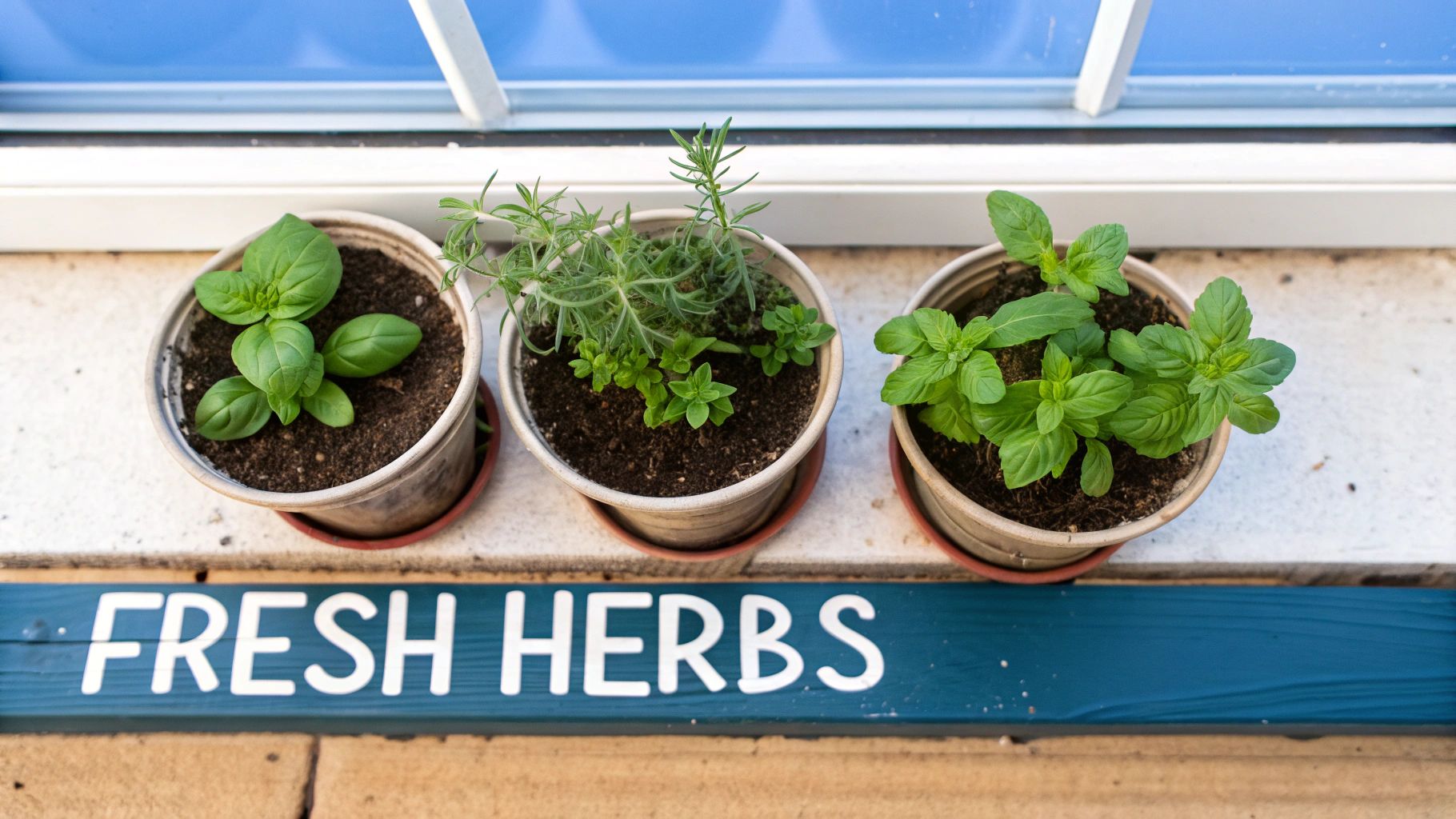
If growing vegetables feels like too big of a commitment right now, herbs are the perfect way to dip your toes into gardening. They are some of the most forgiving plants out there, giving you a huge return in flavor for just a little bit of effort and space.
Honestly, a sunny windowsill or a small pot on the patio is all you need to get started. There’s something special about snipping your own fresh basil for a pasta sauce or grabbing some mint for a cool drink. These four herbs are practically foolproof, designed to grow well with minimal fuss and keep your kitchen stocked with fresh flavor.
6. Mint: The Unstoppable Grower
Mint has a legendary reputation for its vigor. So much so that the biggest challenge isn't keeping it alive—it's stopping it from taking over! That's precisely why mint is the perfect plant for a container, where its ambitious roots can't stage a garden coup.
Just plant it in some standard potting mix, find a spot that gets morning sun and a little afternoon shade, and keep it watered. It’s not picky and will reward you with explosive growth.
- Best Use: That cool, refreshing flavor is a game-changer in teas, mojitos, and fruit salads.
- Harvesting Tip: Don't be shy! Snip stems often to encourage the plant to grow bushier and fuller. The more you cut, the more it gives back.
7. Basil: The Summer Sun Lover
Basil just is summer. Its sweet, aromatic leaves are the heart and soul of a good pesto and so many other classic dishes. This herb absolutely adores heat and sunlight, so give it the sunniest, warmest spot you’ve got. A south-facing window is prime real estate for growing it indoors.
It does like its soil to stay consistently moist, so check the pot often and don't let it dry out completely, especially on hot days. Basil is also one of the most satisfying herbs to start from seed, as it sprouts super quickly in warm soil.
Basil is an annual herb, which means it lives its whole life in one season. To keep a steady supply of leaves coming, just pinch off any flower heads the moment you see them. This tells the plant to focus its energy on making more of those delicious leaves instead of going to seed.
8. Chives: The Hardy Perennial
A wonderfully low-maintenance member of the onion family, chives offer a delicate, mild onion flavor that's never overpowering. They grow in beautiful grassy clumps and are perennials, meaning they come back reliably year after year. Talk about a great long-term investment for your garden!
Chives thrive in full sun but will do just fine with a bit of light shade. Plant them in well-draining soil and give them a drink whenever the top inch of soil feels dry. If you're looking for more year-round options, check out these other easiest herbs to grow indoors.
- Best Use: Their subtle kick is perfect for sprinkling over baked potatoes, scrambled eggs, soups, and salads.
- Harvesting Tip: Grab a pair of scissors and snip the green tops, leaving about two inches behind. They'll regrow in no time for your next harvest.
9. Parsley: The Versatile Staple
Whether you prefer the flat-leaf (Italian) or curly variety, parsley is a true kitchen workhorse. It’s packed with nutrients and has a fresh, clean flavor that brightens up almost any savory dish you can think of. It's a biennial, which means it typically has a two-year life cycle.
Parsley loves rich, moist soil and prefers full sun, though it can handle partial shade. It’s equally happy in containers or garden beds. The key is regular harvesting—trimming the outer stems encourages fresh new growth from the center, ensuring you have a steady supply.
The 4 Easiest Flowers for Non-Stop Color
Growing your own food is a special kind of rewarding, but let's be honest—nothing transforms a garden or patio quite like a riot of colorful flowers. The good news is you don't need a "green thumb" or years of experience to create a stunning floral display. It's all about picking the right plants.
The secret is to choose flowers that are naturally tough, bloom their hearts out, and don't need you to hover over them. These four are some of the absolute easiest to grow for a whole season of color. They're perfect for attracting bees and butterflies, filling in empty garden beds, or just brightening up a few pots on the porch.
10. Marigolds: The Pest-Fighting Powerhouse
There's a reason marigolds are a garden classic. These cheerful golden, orange, and red flowers are a breeze to grow from seed and are famously unfussy. Give them a sunny spot, and they'll handle hot, dry spells with grace once they get their roots down.
But marigolds are more than just a pretty face; they're also a gardener's secret weapon. Their distinct scent naturally repels many common garden pests, including nasty nematodes that live in the soil. Tucking a few marigolds around your tomato plants is a smart, organic way to protect your veggies while adding a pop of vibrant color.
11. Zinnias: The Cut-and-Come-Again Champions
If you dream of having fresh-cut bouquets all summer long, you need to grow zinnias. Period. They burst forth in a dazzling rainbow of colors and forms, from simple, daisy-like petals to giant, ruffled pom-poms. Zinnias absolutely love heat and sun, so they'll put on their best show during the peak of summer.
They're the ultimate "cut-and-come-again" flower. The more you snip blooms for your vase, the more flowers the plant pumps out. Harvesting actually signals the plant to branch out and produce even more buds, giving you a non-stop supply of color right up until the first frost.
One of the best things about zinnias is how easy they are to grow directly from seed. Just poke the seeds into the soil in a sunny spot after your last frost, give them a little water, and watch them take off.
12. Sunflowers: The Easiest Garden Giant
Is it even summer without a towering sunflower? These are some of the simplest flowers to grow straight from seed, which makes them a fantastic project to do with kids. And while we all picture the massive giants, you can also find smaller, branching varieties that are perfect for pots or tighter garden spaces.
Once their deep taproot gets established, sunflowers are incredibly tough and drought-tolerant. All they really ask for is a spot with at least 6-8 hours of direct sun each day. Come fall, you can leave the seed heads on the stalks for the birds to feast on, bringing your garden’s story full circle.
13. Cosmos: The Whimsical Wildflower
With their delicate, daisy-like flowers dancing on tall, feathery stems, cosmos bring a light, airy feel to the garden. These hardy annuals are ridiculously easy to care for and have a surprising quirk: they actually bloom better in poor soil. If you over-fertilize them, you'll get a ton of green leaves but hardly any flowers.
Cosmos are workhorses, producing an endless stream of blooms all summer with almost no help from you. They also tend to self-seed, so don't be surprised if a new patch of cosmos pops up next spring—a lovely gift from last year's garden. This makes them a fantastic, low-cost way to fill a sunny spot with effortless, wildflower-style beauty.
3 Common Questions for New Gardeners
Starting your first garden can feel a bit like learning a new language—it's exciting, but there are always a few tricky questions that pop up. Let's tackle some of the most common ones so you can get your hands dirty with confidence.
Think of this as your gardening FAQ. We've gathered practical, no-nonsense answers to help you sidestep the usual beginner mistakes and get straight to the good stuff.
14. What Is the Single Easiest Plant to Keep Alive Indoors?
If you're looking for a plant that's practically indestructible, meet the Snake Plant (Dracaena trifasciata). It's the champion of low-maintenance houseplants for a reason.
This plant is incredibly forgiving. It puts up with low light, doesn't mind if you forget to water it for weeks, and generally thrives on a bit of neglect. It’s the perfect green companion to have around while you're still figuring things out.
15. Do I Need Special Soil for These Plants?
You don't need to get overly complicated, but you definitely shouldn't just scoop dirt from your backyard into a pot. A good-quality, all-purpose potting mix is your best friend, especially for container gardening. It's designed to provide the right balance of drainage, aeration, and nutrients that most vegetables, herbs, and flowers need to thrive.
A critical mistake is using soil directly from your yard for containers. It's often too dense, compacts easily, and can contain pests or diseases that will harm your plants.
Once you've chosen your beginner-friendly plants, understanding how to keep them thriving is key; you can find more detailed information in comprehensive plant care and maintenance guides.
16. How Often Should I Really Water My Plants?
Forget about a strict schedule. The best way to know when to water is to let the plant tell you.
Simply stick your finger about an inch or two into the soil. If it feels dry, it’s time for a drink. If you still feel moisture, hold off for another day or two. Remember, overwatering is the number one mistake new gardeners make. When in doubt, it’s always better to be a little too dry than a little too wet.
Can I Grow Vegetables on a Balcony with Limited Sun?
Absolutely! You just have to be strategic about what you plant. While sun-worshippers like tomatoes and peppers need a solid 6-8 hours of direct sunlight, plenty of other delicious edibles are happy with less.
- Leafy Greens: Plants like lettuce, spinach, and kale do remarkably well in partial shade, only needing around 4-6 hours of sun.
- Herbs: Many herbs, including mint and parsley, are also quite tolerant of shadier spots.
Ready to start your own garden with seeds that are guaranteed to grow? At Homegrown Garden, we offer a wide variety of heirloom seeds, beginner-friendly kits, and all the supplies you need for a successful harvest. Find your perfect plants today at https://www.homegrown-garden.com.

